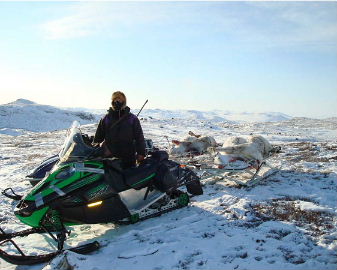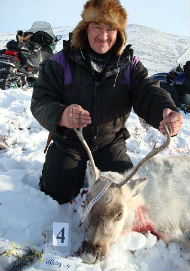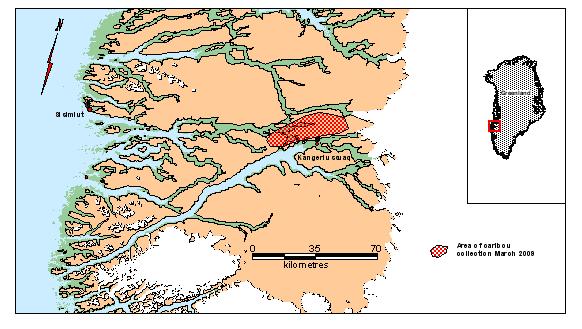Summary
In March 2009, the Greenland Institute of Natural Resources (GINR) examined the Kangerlussuaq-Sisimiut caribou population in West Greenland for body condition and health using CARMA protocols. We collected 40 caribou cows and 10 calves (born spring 2008) from the North region in roughly the area about the Arctic Circle 67° N and 50.5° W. Sukkertoppen Ice Cap forms the southern border of the North region and Nordre Strømfjord the northern border. Similar to the collection made from the Akia-Maniitsoq herd in the spring of 2008, once again the initial data collected included the following; date, location, elevation, sex, age classification (calf, sub-adult (<3-years) or adult) and the presence, absence and condition of antlers, calf-at-heel, milk in udders or calf antlers and gross body measurements (see field data sheet). A photo record for each animal was kept. Important parameters included body, bone, fat and organ weights and measurements, tooth wear, and body condition score. Samples collected included blood, muscle, liver, kidney, urine, rumen contents, bone marrow, bone (mandible, metatarsus), ovaries, foetal tissues, feces, abomasums, small intestine contents, milk, and hair. We checked for a variety of parasites including protozoa, nematodes, tapeworms, flukes and flies (e.g., besnoitia, lung worm and hydatid cysts, liver flukes, liver cysts, Tænia & Sarcocystis cysts, Seteria worms, Sinus tapeworm, warbles & bots). The disease Brucellosis (never observed in Greenland) was assessed by visual appraisal, while blood or fecal samples allowed testing for other pathogens and Johne's disease. Marrow fat content has been completed and retrospective analysis of the ovaries begun. Although not yet complete, intended analyses include tooth ageing, environmental contaminants, nitrogen isotopes in urine blood and muscle, DNA, milk fat, and parasite or disease presence in tissues collected.
Sisimiut hunting officer Hans Mølgaard with caribou on sleds: photo by C. Cuyler
The caribou collection and analysis was funded by GINR and CARMA (CircumArctic Rangifer Monitoring & Assessment). Participants included GINR project leader and scientist Christine Cuyler, GINR scientist Josephine Nymand, scientist Karin Orsel (University of Calgary, Alberta, Canada) and Rán Þórarinsdóttir
(Náttúrustofa Austurlands, Iceland), GINR biology assistant Sofie Ruth Jeremiassen, Sisimiut hunting officer Hans Mølgaard and his assistant Akkalo Lyberth, as well as Morten Lyberth the hunting officer assistant from Maniitosq. The skidoos and sleds were provided by GINR and Hans Mølgaard. The Kangerlussuaq International Science Support centre provided accommodation and laboratory facilities. The centre is located at the Kangerlussuaq airport (Søndre Strømfjord).
Sisimiut hunting officer Hans Mølgaard with caribou cow KQ09-04: photo by C. Cuyler
Results
Our collection period was 3-17 March 2009. We examined the Kangerlussuaq-Sisimiut caribou population in West Greenland. We culled 50 caribou, which included 40 cows (36 adults and four sub-adults) and 10 calves (six females and four males). Cows over 3-years were considered adults, and those under 3-years sub-adults. Age classification was based on the presence of a full set of adult teeth. All calves were about 10-months old, and associated with one of the culled cows, as calf-at-heel. To obtain the animals, an average of 62 km was travelled each day by snowmobile. About 301 caribou in total were observed. Average group size was 2.9 ± 2.2 SD caribou. Maximum group size was 14. The animals varied from extremely shy of our presence to only mild avoidance. Thus shooting distances were reduced compared to last year's Akia-Maniitsoq caribou collection. Average shooting distance was 157 ± 57 SD metres, with a maximum of 278 metres (measured by laser distance finder). Waterproof identification tags were again useful for the several hour long transport to the laboratory. Calf-at-heel, and any foetus, received the same identification number as the mother. The database is still being filled in and many samples are not yet analysed.
Figure 1. The Kangerlussuaq area where 40 caribou cows and 10 calves-at-heel were collected in March 2009 for body condition and health analysis.
Key samples collected are detailed in the field data sheets. Briefly these were date, location, elevation, sex, age classification (calf, sub-adult (<3-years) or adult) and the presence, absence and condition of antlers, calf-at-heel, milk in udders or calf antlers and gross body measurements (see field data sheet). A photo record for each animal was kept. Important parameters included body, bone, fat and organ weights and measurements, tooth wear, and body condition score. Samples collected included blood, muscle, liver, kidney, urine, rumen contents, bone marrow, bone (mandible, metatarsus), ovaries, foetal tissues, feces, abomasums, small intestine contents, milk, and hair. We checked for a variety of parasites including protozoa, nematodes, tapeworms, flukes and flies (e.g., besnoitia, lung worm and hydatid cysts, liver flukes, liver cysts, Tænia & Sarcocystis cysts, Seteria worms, Sinus tapeworm, warbles & bots). The disease Brucellosis (never observed in Greenland) was assessed by visual appraisal, while blood or fecal samples allowed testing for other pathogens and Johne's disease.
Of special note, was the need to carefully make a small opening for the escape of rumen gas during transport of the carcasses. Unlike the winter diet of Akia-Maniitsoq caribou, the Kangerlussuaq-Sisimiut herd consume predominantly graminoids in copious quantities. Within relatively short time periods, the graminoids caused excessive expansion and rupture of the rumen. A tiny belly slit allowing gases to escape avoided this problem altogether.
Applications
The West Greenland cull of caribou in March 2009 provided important data on cow body size / condition, health and reproduction, which can be compared with data collected from the same herd in 1996-1997. Relating the results to the Kangerlussuaq-Sisimiut caribou demographics may provide some answers to questions regarding calf production and survival in this herd and climate change.
No reports available yet.
Download 2009 field and lab proceedures (5.4MB)
Download 2009 Field data sheet (215kB)
Contacts
Christine Cuyler, Ph.D.
Research Scientist
Greenland Institute of Natural Resources
Kivioq 2
P.O. Box 570
DK - 3900 Nuuk
GREENLAND
Telephone: (+299) 36 12 00
Direct Telephone: (+299) 36 12 40
Fax: (+299) 36 12 12
E-mail: chris.cuyler'at'natur.gl
website: www.natur.gl
Josephine Nymand, Ph.D.
Research Scientist
Greenland Institute of Natural Resources
Kivioq 2
P.O. Box 570
DK - 3900 Nuuk
GREENLAND
Telephone: (+299) 36 12 00
Direct Telephone: (+299) 36 12 34
Fax: (+299) 36 12 12
E-mail: jony'at'natur.gl
website:
Fernando Ugarte
Head of Department of Mammals & Birds
Greenland Institute of Natural Resources
Kivioq 2
P.O. Box 570
DK - 3900 Nuuk
GREENLAND
Tel: (+299) 36 12 00
Direct Tel: (+299) 36 12 42
Fax: (+299) 36 12 12
E-mail: feug'at'natur.gl
website:



